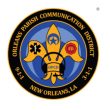Harris unveils multiband portable radio for first responders
Harris Corp. yesterday introduced a multiband portable radio for the first-responder sector that operates in both VHF (low- and high-band) and UHF (low- and high-band) modes. The company is targeting the federal level first, but said it expects to eventually introduce models for state and local agencies.
The RF-1033M is an offshoot of multiband radios that Harris has been producing for the military sector during the last decade, said Kevin Kane, director of U.S. product development for Harris.
“We have a very strong reputation for secure, reliable communications in some of the most difficult conditions on earth,” Kane said during an interview with MRT. “We have developed a lot of technology that we think is very relevant to the federal-agency marketplace, especially with respect to technologies that enable interoperability.”
While interoperability certainly is needed during major incidents, that need goes well beyond mega-events such as Hurricane Katrina and has trickled down to everyday situations, according to Kane. For example, drug trafficking is a major problem in the Miami area, he said.
“There hasn’t been a … direct method for interoperability among all of the players there, whether it be the DEA, the Coast Guard, the Dade County Sheriff and the Florida State Police,” Kane said. “Our radio covers multiple frequency bands, which to date, no one in the public-safety marketplace is doing.”
While multiband radios have been available to amateur-radio operators for years, they haven’t delivered the ruggedness and features required by first responders, said Matt Fallows, product manager for Harris.
“I don’t believe that multiband technology has been put together in a package that does things like support APCO Project 25. Ham radios are not necessarily intended for a professional market,” Fallows said, adding that the RF-1033M supports P25 and enables AES and DES encryption.
Ben Holycross, radio communications manager for Polk County, Fla.—a vocal advocate for the development of multiband radios for the public-safety sector—called the introduction of the RF-1033M a “great start” but said he was disappointed that Harris “stopped short” at the federal level. Nevertheless, he welcomed Harris’s foray into the first-responder sector.
“Harris is a big federal contractor, they’re good people and they’ve built really good stuff over the years for the military,” Holycross said. “Frankly, they’ve done multi-band radios for the military for a long time.”
Holycross said Harris’s introduction means vendors finally are paying heed to public safety’s cry for multiband products. “We’re starting to get the manufacturers’ attention that [interoperability] is a problem area that needs to be fixed. The step taken by Harris is a good thing and, hopefully, a portent of things to come,” he said.
Holycross said the myriad crosspatch solutions currently on the market have been “lifesavers” but called them “band-aid” approaches to interoperability.
“We’ve been involved in several events where you have 700 police officers out there in the dark hunting a bad guy. When you have 700 police officers with itchy trigger fingers in the dark, if they can’t talk to each other, there’s going to be friendly-fire incidents. We’ve been real fortunate that we’ve been able to avoid that, but it’s just not true interoperability,” Holycross said.
“If we can get to the point, from an RF standpoint, … where we can get some cognitive capabilities so that you can do some ad-hoc network creation, oh man, that will be the be-all-end-all. We’re not there yet, but we are getting closer.”

















